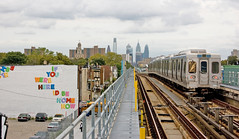Love Letter, a project of the Philadelphia Mural Arts Program demonstrates the toils of love.
What would you do if someone wrote you a love letter and displayed it publicly on rooftops and walls in West Philadelphia?

This is the question City of Philadelphia Mural Arts Program (MAP) and internationally renowned artist Stephen Powers posed when they gathered 40 international and local artists to express their feelings through the walls.
In this public art project, “Love Letter,” more than 50 buildings and rooftops are adorned with messages of love, raw emotion and angst. Love Letter extends in and around the Market Street corridor in West Philadelphia, spanning 46th to 63rd streets.
The letters, modern and timeless, are for the commuters, the people of West Philly and for the artists with whom Powers connects, he said.
“[Love Letter] is homage to the only graffiti that ever matters,” Powers said. “It’s been done everywhere around the world and has been happening for eons. It’s a declaration of love for one’s amore written on a wall, a tree or a cave.”
Love Letter is in honor of the message graffiti artist Cornbread once painted: “Cornbread loves Cynthia.” Powers said it’s the best graffiti Cornbread ever did, before the message became distorted and what was once done out of love was done for fame.
“It was like that way for generations,” said Powers. “[Graffiti artists] did it for fame and not love. We loved doing it, but we all wanted to be famous. Once I got to the point where I had more fame than I wanted, and it wasn’t really doing it for me [anymore], I could get back to doing it as an expression for love. It is much more affective that way.”
The walls where Powers and his team painted the love letters were once painted with tag names. After 25 years, they were painted brown, and no one could even remember when they were originally created. Those names and stories bore a cultural significance, but because they were tags, no one could take ownership of them.
Powers said he saw this as the perfect opportunity to play around with colors and the medium to make something different, to paint the walls again and create something unified.
“I wanted to see if I stripped out ego, legality, the issues of crime and trespassing and all of the negative connotations associated with graffiti, and I put in an emotional content, a narrative, a depth of character and dialogue, if I could reinvent the form as something people would take ownership of and have a lot of pride and joy in,” Powers said. “It’s the only form of graffiti that transcends place and time.”
Powers painted a love story on the walls of Dublin and Belfast, Northern Ireland, as a Fulbright Scholar in 2008. For this project, he brings the love home to the streets where he first started.
Powers grew up in Overbrook, West Philadelphia in the 1980s and started to paint at 15, with the tag name “Espo.” At the time, the MAP was part of the Philadelphia Anti-Graffiti Network, charged with rehabilitating graffiti artists and providing them other artistic outlets.
Powers didn’t want to join forces with them because then, he wouldn’t have been able to use spray paint as his medium, he said.
“I had all the freedom I wanted as a youth on the street and used all materials I wanted,” he said.
Now, in an ironic partnership, Powers has joined forces with Executive Director of the MAP Jane Golden to create art people in West Philly will care about.
The Love Letter project is funded by The Pew Center for Arts & Heritage through the Philadelphia Exhibitions Initiative. For this grant, Powers had to work together with a local organization, MAP.
Love Letter is a collection of the 50 murals, two books and a corresponding film. One book will document the walls and will be sold in local area businesses, so people get off the train and into the neighborhood. The other book, a coffee table book, will include the inspiration behind Love Letter, the people in the project, along with graffiti from Philadelphia in the 1980s and Powers’ murals in Dublin and Belfast.
The film will parallel the murals and give a narrative back-story to Love Letter and Philly youth dealing with love and relationships. It will be directed by Joey Garfield and produced by the New York City production company Ghost Robot.
Powers and the MAP also created a sign-painting enterprise to train young people in the neighborhood and provide local businesses with signage.
The initial reaction, Powers said, was confusion because the MAP does not tend to create art with more text than images in its works. As time goes on, the neighborhood is beginning to respond more positively.
Melanie Menkevich can be reached at melanie.menkevich@temple.edu.



QUALITY I really like this, it reminds me of a graffiti artist I saw at http://www.hire-a-graffiti-artist.co.uk their is a few more good graffiti artists on the site.